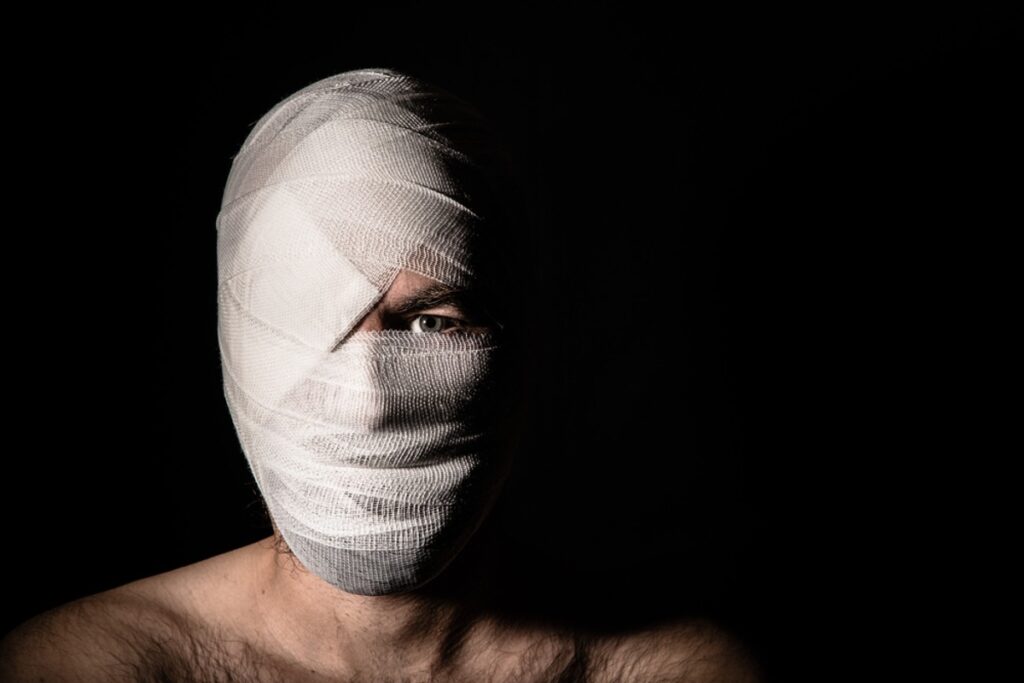Degloving injuries are a type of severe trauma that occurs when the skin and underlying tissues are torn away from the bones, muscles, nerves, and blood vessels. This article will explore the causes, symptoms, diagnosis, treatment, and long-term effects of degloving injuries, with a focus on the face.
Understanding Degloving Injuries
What is a degloving injury?
A degloving injury is a medical term for a condition where the skin and subcutaneous tissues are detached from the deeper structures of the body. The term “degloving” comes from the analogy of removing a glove from a hand. Degloving injuries can affect any part of the body, but they are most common in the limbs, especially the hands and feet. However, degloving injuries can also occur in the face, scalp, torso, and genitalia.
Types of degloving injuries
Degloving injuries can be classified into two types: complete and incomplete. A complete degloving injury is when the skin and subcutaneous tissues are completely separated from the underlying structures, leaving a raw and exposed surface. An incomplete degloving injury is when the skin and subcutaneous tissues are partially detached, creating a flap or pocket of tissue that can be reattached.
Symptoms and causes
The symptoms of a degloving injury depend on the extent and location of the injury, but they generally include:
- Severe pain
- Bleeding
- Swelling
- Bruising
- Loss of sensation
- Loss of function
- Infection
- Shock
The causes of a degloving injury are usually related to high-energy trauma, such as:
- Motor vehicle accidents
- Industrial accidents
- Animal bites
- Burns
- Explosions
- Gunshot wounds
- Falls
Diagnosis
The diagnosis of a degloving injury is based on the physical examination of the wound and the history of the trauma. Imaging tests, such as X-rays, CT scans, or MRI scans, may be used to assess the extent of the damage and the involvement of the bones, muscles, nerves, and blood vessels. Laboratory tests, such as blood tests or cultures, may be used to check for infection or other complications.
Treatment and Recovery
Emergency treatment
The immediate treatment of a degloving injury is aimed at controlling the bleeding, preventing infection, and stabilizing the patient. The wound should be covered with sterile dressings and bandages, and the patient should be given fluids, antibiotics, and painkillers. The patient should be transported to a hospital as soon as possible, where they will undergo further evaluation and treatment by a team of specialists, such as plastic surgeons, orthopedic surgeons, neurosurgeons, and vascular surgeons.
Surgical options
The surgical treatment of a degloving injury depends on the type and severity of the injury, but it usually involves one or more of the following procedures:
- Debridement: The removal of dead or damaged tissue from the wound to prevent infection and promote healing.
- Replantation: The reattachment of the detached skin and subcutaneous tissues to the underlying structures, using sutures, staples, or glue. This is only possible for incomplete degloving injuries, and it requires a good blood supply and nerve function in the affected area.
- Skin grafting: The transplantation of healthy skin from another part of the body or a donor to cover the wound. This is usually done for complete degloving injuries, or when replantation is not feasible or successful.
- Flap surgery: The transfer of a piece of skin and subcutaneous tissues, along with their blood vessels and nerves, from one part of the body to another, to cover the wound. This is usually done for large or complex degloving injuries, or when skin grafting is not sufficient or available.
- Microsurgery: The use of a microscope and specialized instruments to repair the damaged blood vessels and nerves in the wound, to restore the blood flow and sensation in the affected area.
Rehabilitation
The recovery from a degloving injury can take several weeks to months, depending on the extent and location of the injury, the type and quality of the surgical treatment, and the patient’s overall health and compliance. The patient will need to follow a rehabilitation program that includes:
- Wound care: The patient will need to keep the wound clean and dry, and change the dressings and bandages regularly, to prevent infection and promote healing. The patient will also need to take antibiotics and painkillers as prescribed by the doctor.
- Physical therapy: The patient will need to do exercises and stretches to improve the range of motion and strength of the affected area, and to prevent stiffness and contractures. The patient will also need to wear splints or braces to support and protect the affected area, and to prevent deformities.
- Occupational therapy: The patient will need to learn how to perform daily activities, such as eating, dressing, grooming, and working, with the affected area, and to use adaptive devices or techniques to assist them. The patient will also need to learn how to care for the affected area, such as applying moisturizers, sunscreens, or cosmetics, and to avoid trauma, pressure, or extreme temperatures.
- Psychological therapy: The patient will need to cope with the emotional and social impact of the degloving injury, such as the loss of function, appearance, and identity, and the possible stigma, discrimination, or isolation. The patient will also need to deal with the trauma, stress, anxiety, depression, or post-traumatic stress disorder (PTSD) that may result from the injury. The patient may benefit from counseling, support groups, or peer mentoring, to help them adjust and adapt to their new situation.
Complications and Long-term Effects
Potential complications
The potential complications of a degloving injury include:
- Infection: The wound may become infected by bacteria, fungi, or viruses, which can cause inflammation, pus, fever, or sepsis. The infection may spread to the surrounding tissues, bones, or bloodstream, and cause serious or life-threatening consequences.
- Necrosis: The wound may lose its blood supply and oxygen, which can cause the tissue to die and turn black or gangrenous. The necrotic tissue may need to be removed surgically, or it may fall off spontaneously.
- Hematoma: The wound may accumulate blood under the skin or subcutaneous tissues, which can cause swelling, pain, or pressure. The hematoma may need to be drained surgically, or it may reabsorb naturally.
- Seroma: The wound may accumulate fluid under the skin or subcutaneous tissues, which can cause swelling, pain, or leakage. The seroma may need to be drained surgically, or it may reabsorb naturally.
- Scarring: The wound may heal with abnormal or excessive scar tissue, which can cause itching, pain, tightness, or contractures. The scar tissue may affect the appearance, function, or sensation of the affected area, and may require further surgery or treatments to improve or reduce it.
- Nerve damage: The wound may damage the nerves in the affected area, which can cause numbness, tingling, burning, or pain. The nerve damage may affect the sensation, function, or movement of the affected area, and may require further surgery or treatments to repair or restore it.
- Vascular damage: The wound may damage the blood vessels in the affected area, which can cause bleeding, bruising, or ischemia. The vascular damage may affect the blood flow, oxygen, or nutrients to the affected area, and may require further surgery or treatments to repair or restore it.
- Bone damage: The wound may damage the bones in the affected area, which can cause fractures, dislocations, or infections. The bone damage may affect the structure, stability, or alignment of the affected area, and may require further surgery or treatments to repair or restore it.
- Muscle damage: The wound may damage the muscles in the affected area, which can cause weakness, atrophy, or spasms. The muscle damage may affect the function, movement, or coordination of the affected area, and may require further surgery or treatments to repair or restore it.
Impact on physical and emotional well-being
The impact of a degloving injury on the physical and emotional well-being of the patient can be significant and long-lasting. The patient may experience:
- Pain: The patient may experience chronic or acute pain in the affected area, which can interfere with their daily activities, sleep, or mood. The pain may be caused by the injury itself, the surgical treatment, the scar tissue, the nerve damage, or the psychological factors. The patient may need to take painkillers or other medications, or use alternative therapies, such as acupuncture, massage, or hypnosis, to manage their pain.
- Disfigurement: The patient may experience changes in the appearance of the affected area, which can affect their self-esteem, confidence, or identity. The patient may feel ashamed, embarrassed, or insecure about their looks, and may avoid social situations, intimacy, or exposure. The patient may need to use cosmetic products, such as makeup, wigs, or prosthetics, or undergo further surgery or treatments, such as laser, injections, or implants, to improve their appearance.
- Disability: The patient may experience limitations in the function or movement of the affected area, which can affect their independence, productivity, or quality of life. The patient may have difficulty performing daily activities, such as eating, dressing, grooming, or working, and may need assistance, devices, or adaptations to help them. The patient may also have difficulty participating in hobbies, sports, or leisure activities, and may need to modify, change, or give up on them. The patient may need to find new ways to enjoy their life, or discover new interests or passions.
- Depression: The patient may experience low mood, sadness, hopelessness, or loss of interest in things they used to enjoy, which can affect their mental health and well-being. The patient may feel isolated, lonely, or misunderstood, and may have suicidal thoughts or attempts. The patient may need to seek professional help, such as a psychiatrist, psychologist, or counselor, or take antidepressants or other medications, to treat their depression.
- Anxiety: The patient may experience fear, nervousness, or worry about their future, their health, or their safety, which can affect their mental health and well-being. The patient may have panic attacks, phobias, or obsessive-compulsive disorder (OCD), and may avoid certain situations, places, or people that trigger their anxiety. The patient may need to seek professional help, such as a psychiatrist, psychologist, or counselor, or take anti-anxiety or other medications, to treat their anxiety.
- PTSD: The patient may experience flashbacks, nightmares, or intrusive thoughts about the traumatic event that caused their injury, which can affect their mental health and well-being. The patient may have difficulty sleeping, concentrating, or remembering things, and may feel angry, irritable, or guilty. The patient may also have hyperarousal, hypervigilance, or avoidance behaviors, and may be easily startled, frightened, or distressed. The patient may need to seek professional help, such as a psychiatrist, psychologist, or counselor, or take anti-PTSD or other medications, to treat their PTSD.
Conclusion
Degloving injuries are a type of severe trauma that occurs when the skin and underlying tissues are torn away from the bones, muscles, nerves, and blood vessels. Degloving injuries can affect any part of the body, but they are most common in the limbs, especially the hands and feet. However, degloving injuries can also occur in the face, scalp, torso, and genitalia. Degloving injuries can cause significant physical and emotional damage, and require prompt and proper treatment and rehabilitation. Degloving injuries can also lead to various complications and long-term effects, such as infection, necrosis, scarring, nerve damage, vascular damage, bone damage, muscle damage, pain, disfigurement, disability, depression, anxiety, or PTSD. Degloving injuries can have a profound impact on the patient’s life, and they may need ongoing support and care to cope and recover. Degloving injuries are a harsh truth that needs to be unveiled and understood, to prevent, treat, and heal them effectively.








